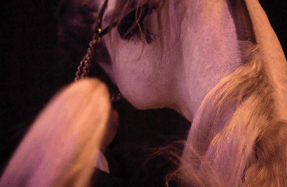

The best approach is on foot. Set out from the village of Gomadingen in the early morning and follow the course of the river Lauter along the valley. The path runs parallel to the road and the river on the left and a small railroad track on the right, but if you stick to the path for walkers and cyclists, you will see so much more: herons wading in the water, dragonflys flitting across the grass, red kites circling high in the sky above. After following the stream for half a mile, you leave the path, take the bridge across the river to your left, cross the road, and follow the footpath leading uphill into the forest. There in the woods, you may encounter something you will see nowhere else: on the rise ahead of you, a magnificent black chestnut draft stallion appears, with a long, near-white flowing mane and tail. On his bare back sits a young girl. With a cheerful greeting, horse and rider pass by and disappear down the path. As you continue onwards and begin to descend the hill out of the trees into the open, you will see a large pasture spread out in front of you, its green expanse dotted with the white shapes of quietly grazing Arabian mares.
Welcome to Marbach, the oldest state stud and the oldest Arabian breeding program in the world.
I All the King’s Horses
It began, as so many great things do, with one man and a vision. The year was 1817 and the area that would later be known as Germany was still divided into several independent kingdoms. One of them was Württemberg, down south just next to Bavaria, a country whose dense woodlands are still known today as the Black Forest and whose mountain plateau, the Swabian Alb, is one of the coldest places in the country where the snows arrives earlier and lasts longer than anywhere else. Beneath its rough surface hides a vast system of caverns and underground lakes that delight both geologists and archeologists to this day. Württemberg is also one of the oldest horsebreeding countries, which is reflected in the very name of its capital city: Stuttgart, which is derived from “Stutengarten,” literally meaning “a garden full of mares” - a stud farm. Marbach as a stud farm was founded as far back as 1514, high up on the Alb, 700 meters above sea level. Like most state studs, its original purpose was to produce remounts for the cavalry and to provide a stallion depot for the use of horsebreeding farmers.
The story of its Arabian herd begins a few miles away at the royal domain of Weil on the river Neckar. Wilhelm, Crown Prince of Württemberg, was a keen horseman and had come to know and appreciate Arabian horses during the Napoleonic Wars, where his charger was a bay Arabian stallion called Emir. At that time pure Arabian horses were not bred in Europe, though their qualities were much appreciated, especially by the cavalry. To get these qualities, Arabian stallions were imported from the Desert and used to upgrade the local stock, some of them becoming the mounts of generals and kings. Napoleon himself famously preferred to ride Arabian stallions, and Wilhelm’s Emir may have been one of those early imports of which nothing remains now but a name.
Importing horses from Arabia was dramatically different from today. Buyers had to travel long distances to find them, and long distance travel was anything but safe and secure. Such trips took months, even years. But what if it could be done differently? What if you brought back mares as well as stallions, and were able to breed your own supply of pure Arabians? If purebred horses were available in the country, it would no longer be necessary to import them at huge cost and risk. One could simply breed one’s own.
Sooner or later someone had to hit upon this idea, and it was Prince Wilhelm who did. Wilhelm founded his first stud farm in 1810 and already imported Arabians in 1814, but things only took off properly after he ascended the throne as King Wilhelm I in 1816. King Wilhelm






